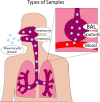Diagnosing Pneumocystis jirovecii pneumonia: A review of current methods and novel approaches
- PMID: 32400869
- PMCID: PMC7657095
- DOI: 10.1093/mmy/myaa024
Diagnosing Pneumocystis jirovecii pneumonia: A review of current methods and novel approaches
Abstract
Pneumocystis jirovecii can cause life-threatening pneumonia in immunocompromised patients. Traditional diagnostic testing has relied on staining and direct visualization of the life-forms in bronchoalveolar lavage fluid. This method has proven insensitive, and invasive procedures may be needed to obtain adequate samples. Molecular methods of detection such as polymerase chain reaction (PCR), loop-mediated isothermal amplification (LAMP), and antibody-antigen assays have been developed in an effort to solve these problems. These techniques are very sensitive and have the potential to detect Pneumocystis life-forms in noninvasive samples such as sputum, oral washes, nasopharyngeal aspirates, and serum. This review evaluates 100 studies that compare use of various diagnostic tests for Pneumocystis jirovecii pneumonia (PCP) in patient samples. Novel diagnostic methods have been widely used in the research setting but have faced barriers to clinical implementation including: interpretation of low fungal burdens, standardization of techniques, integration into resource-poor settings, poor understanding of the impact of host factors, geographic variations in the organism, heterogeneity of studies, and limited clinician recognition of PCP. Addressing these barriers will require identification of phenotypes that progress to PCP and diagnostic cut-offs for colonization, generation of life-form specific markers, comparison of commercial PCR assays, investigation of cost-effective point of care options, evaluation of host factors such as HIV status that may impact diagnosis, and identification of markers of genetic diversity that may be useful in diagnostic panels. Performing high-quality studies and educating physicians will be crucial to improve the rates of diagnosis of PCP and ultimately to improve patient outcomes.
Keywords: Pneumocystis; Pneumocystis pneumonia; antigen-antibody reaction; immunocompromised host; polymerase chain reaction.
© The Author(s) 2020. Published by Oxford University Press on behalf of The International Society for Human and Animal Mycology.
Figures



References
-
- Thomas CF Jr., Limper AH. Pneumocystis pneumonia. N Engl J Med. 2004; 350: 2487–2498. - PubMed
-
- Kovacs JA, Masur H.. Evolving health effects of Pneumocystis: one hundred years of progress in diagnosis and treatment. JAMA. 2009; 301: 2578–2585. - PubMed
-
- de Souza W, Benchimol M. Basic biology of Pneumocystis carinii: a mini review. Mem Inst Oswaldo Cruz. 2005; 100: 903–908. - PubMed

